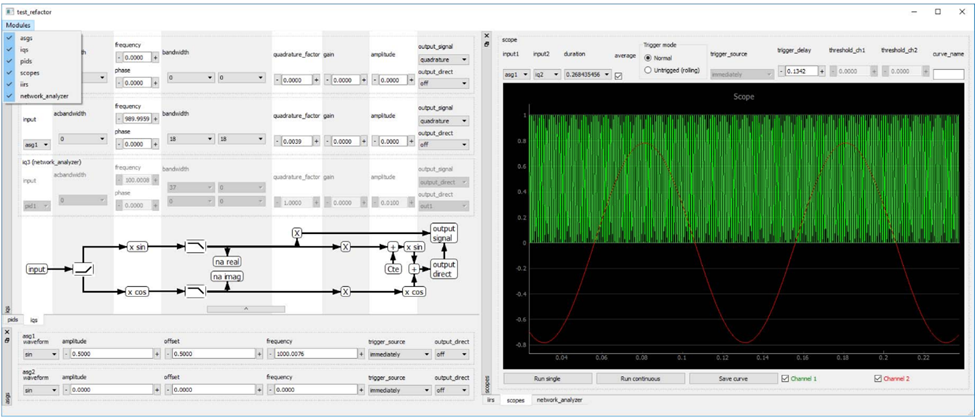PyRPL – Open-Source FPGA-Controlled Software for Quantum Optics
- Posted by
 Red Pitaya Team
, June 10, 2025
Red Pitaya Team
, June 10, 2025

In the realm of quantum optics, precision and adaptability are paramount. This is where PyRPL (Python Red Pitaya Lockbox) makes its mark. PyRPL is an open-source software package tailored for the affordable and versatile Red Pitaya FPGA platform, unlocking advanced functionalities for experimental quantum optics. Developed by a team from Laboratoire Kastler Brossel, this tool bridges hardware and software to create a customizable digital feedback solution. Now let’s take a closer look at how PyRPL is revolutionizing quantum optics.


The Power of Red Pitaya
At the heart of PyRPL lies a Red Pitaya board, a cost-effective FPGA-based system equipped with high-speed analog inputs and outputs sampled at 125 MHz. Originally designed as a versatile test and measurement device, its flexibility and affordability make it a strong candidate for advanced research applications, including digital feedback control in quantum experiments.
PyRPL: Expanding the Red Pitaya Board's Capabilities
PyRPL extends the Red Pitaya board's functionality by combining Python-based high-level programming with a custom FPGA design in Verilog. This integration empowers researchers to perform the sophisticated digital signal processing tasks necessary for quantum optics, including:
- Oscilloscope and Diagnostics: A two-channel oscilloscope enables precise real-time measurements and system diagnostics.
- Waveform Generation: Dual arbitrary function generators synthesize complex waveforms and noise profiles.
- Advanced Feedback Control: Four PID controllers with up to fourth-order filters provide closed-loop feedback for analog systems.
- Error Signal Generation: Three demodulation modules generate Pound-Drever-Hall-like error signals, critical for frequency stabilization in optics experiments.
- Digital Filters: An infinite impulse response (IIR) filter supports transfer functions with up to 24 poles and zeros, enabling highly precise signal shaping.
- Network and Spectrum Analysis: These tools enable researchers to characterize analog and digital systems while minimizing noise in feedback loops.
A Seamless User Experience
PyRPL combines a graphical user interface (GUI) and a Python API, offering real-time visualization and easy configuration of signal chains and feedback controllers. Researchers can define complex feedback sequences for tasks such as locking high-finesse cavities with finesse values exceeding 100,000.
The system’s Python API also enables advanced users to programmatically reconfigure DSP modules and retrieve signal data with millisecond-scale latencies. This flexibility is invaluable for adapting experiments on the fly or automating complex procedures.
Open-Source Advantage
What sets PyRPL apart is its open-source nature. Unlike proprietary solutions, PyRPL offers complete transparency and adaptability. Researchers can modify both the Python-based interface and the FPGA-level functionalities, making it possible to integrate PyRPL into custom setups or extend its capabilities to meet specific experimental needs.
The growing PyRPL community fosters collaboration and the rapid development of new features. This ensures that the software evolves to meet emerging challenges in quantum optics and beyond.
For more details, see L. Neuhaus et al., “PyRPL” (2016). GitHub Repository.
Applications in Quantum Optics
PyRPL has already demonstrated its value in various quantum optics applications, such as:
- Resonance Stabilization: Using its demodulation modules and PID controllers, PyRPL excels in stabilizing optical cavities with unprecedented precision.
- Noise Minimization: Its spectrum analyzer enables users to diagnose and minimize sources of noise in feedback systems, achieving superior closed-loop performance.
- Custom Digital Filters: Advanced digital filters allow the creation of novel error signals, paving the way for innovative experimental techniques.
Broader Implications and Future Prospects
The adaptability of PyRPL makes it a game-changer not just for quantum optics but also for other domains that require precise digital control, such as cryogenic detector readouts, bioimpedance analysis, and particle physics. Its compatibility with Red Pitaya ensures an affordable entry point for researchers worldwide, democratizing access to high-performance experimental tools.
Future developments aim to enhance FPGA integration, improve real-time performance, and expand community-driven contributions to PyRPL’s feature set.
Conclusion
By combining the affordability of a Red Pitaya board with the advanced capabilities of PyRPL, researchers now have access to a powerful, open-source platform for quantum optics experiments. PyRPL exemplifies how open innovation can overcome traditional barriers, offering scalable and customizable solutions for complex scientific challenges. As the community grows and the software evolves, PyRPL is set to remain at the forefront of experimental quantum technologies, with Red Pitaya along for the ride.


.jpg?width=767&name=blog%20featured%20image%20(100).jpg)
.jpg?width=767&name=blog%20featured%20image%20(85).jpg)
.jpg)
-1.png)